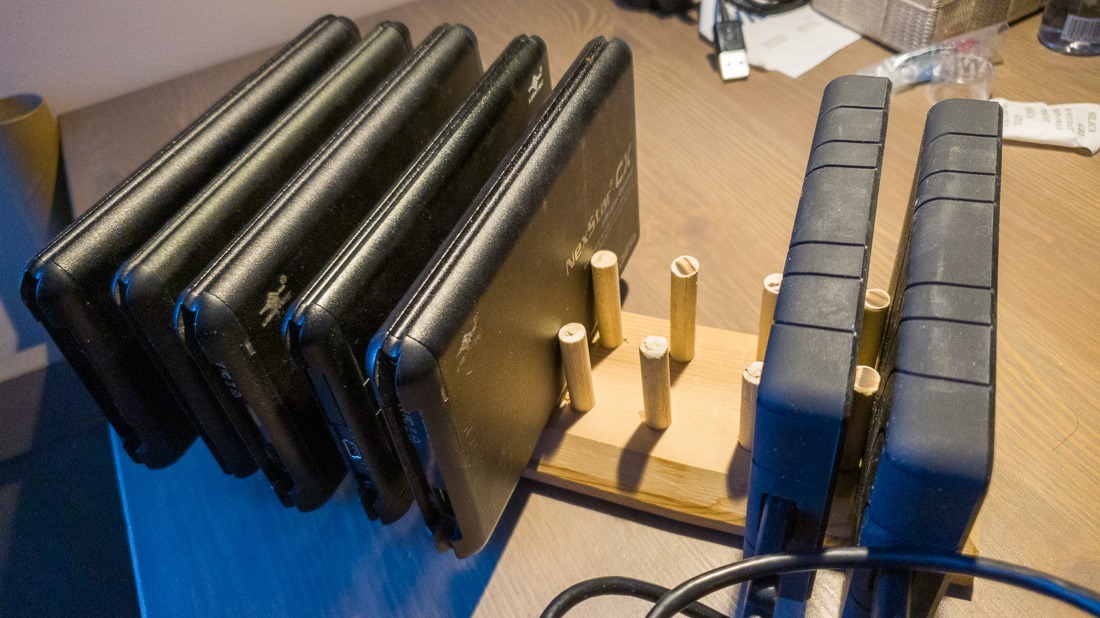It’s the end of the year. 2020 has been a trying year for many of us. The year when plenty of things went off the rails. Your pictures should not become victims of 2020, though. A backup is really necessary for your peace of mind. Heaven knows this peace was disturbed in 2020.

So here is what I often get asked: “What do you do for your backups?”. Now I could be snarky and say “Read my blog posts about that!”, but that is usually not the best way to go about it ![]() .
.
Over time, solutions to a specific problem can change. Not so long ago, a backup solution was a 5.25” floppy disk set, followed by sturdier 3.5” disks. Then came CDs and DVDs. While DVDs now come in an archival quality, their longevity is not guaranteed. In fact, no solution is eternal.
Therefore, we need to update the storage media we are using to stay with the times. So my diskettes became CDs and DVDs. Until I had a closet full of boxes with older (read: obsolete) storage. Today I use basic external hard drives. The 2TeraByte drives I bought a few years ago are now up for replacement. Not by another set of 2TB drives but by a 4TB set.
Little by little the older drives fill up and need to be replaced by bigger ones if I continue to use them in the same way. With a frequently maintained backup, a “new” backup takes only minutes. On January 1st, the whole operation of freeing up internal SSD space and relinking Lightroom to the backup drive for the 2020 photos will take not more than 3 minutes.
Yet, today, the spectre or Siren Chant of Cloud Storage becomes more and more prevalent.
Storing all my pics in the cloud and never think about backing up again is alluring. At least in the beginning. It would definitely be my preferred solution if I were to take pictures only with my cellphone. The pics would go into the cloud and ready to be used on any device.
So I did a little google research to come up with some pricing. First of all, most Cloud Services will remove access to your files the minute you stop paying. Some services not even worth citing here will destroy your files the second your account is overdue. That is no way to handle my pictures.
The first cloud storage that comes to mind is AWS or Amazon Web Services. The S3 Standard storage solution is very affordable. The first 50 TB / Month is only USD0.023 per GB. Sounds reasonable, right? In my case, I have 1.3TB on my system in pictures alone. That leaves me with 29.90 per month to pay for all my pictures in the cloud. There are cheaper solutions like S3 Glacier, but then your pictures are not immediately available to you. There is a wait-time to get the files out of storage for you.
But Lightroom, which is my main management system, does not play with AWS, it can only work with the cloud service from Adobe. 1TB from Adobe comes at 19.90USD per month. There is no space extension possible. So my library does not even fit there.
Other providers will play in the same league. If you only use your cellphone or only shoot in JPG, this may be sufficient. Peace of mind above everything. Other services include Backblaze, at 0.005 USD per GB per month. Less expensive.
But I still have some serious doubts about the privacy of MY pictures in the cloud. Lightroom CC (the cloud version, not Classic) can determine what is in my pictures. The service is called Sensei. Sensei uses cloud intelligence to determine what is in your shot. It is pretty accurate at it as well. The intelligence comes from a vast database of images that have been tagged successfully before. Tagging your own pictures will improve its accuracy. But wait… that means that there are parts or some complete pictures in a service that I did not sign up for. What about boudoir photography and the privacy of the models?
There is plenty of room for arguments on both sides, let’s not go too far into that. The models might not care (I doubt that), One shouldn’t take such pictures (none of your business), cloud space is private (really?) and much more can be said.
The fact is… Cloud storage is nothing more than storage space on machines you do not own and do not manage. You are at the mercy of the company you hired to protect your private stuff. But Amazon is too big to go broke, right? Sure, today it is, but so was The Kodak Company and plenty more.
So I stick with my personal hard drives that I need to replace on a regular basis. If not for lack of space, then only for the fact to keep them young and lively. A 2 TB drive has lasted me for nearly 10 years of photography, a 4TB will double that. By the time the new drive is either old or at its lifespan’s end, newer drives will be available for better, safer and bigger storage. Probably cheaper too.
That 2TB drive cost me something like 120 dollars, less than one single year of Amazon storage. And at least I have my pictures where I want them, close to my heart (ok, on my desk) within reach and instantly available when required.
